Survey says keep improvements to Wellington Beach simple, natural
Administrator | Sep 22, 2022 | Comments 0
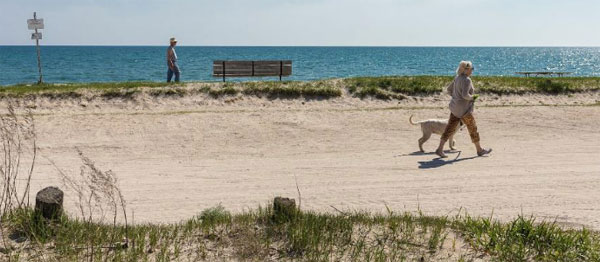
Wellington Beach – Daniel Vaughan photo
Respondents to a recent survey are largely opposed to any significant commercialization of Wellington Beach – preferring improvements with the least amount of environmental impact.
Suggested changes to improve how Wellington beach may function going forward were presented by the Wellington Waterfront Task Team this week.
The Community and Economic Development Commission (CEDC), in its final meeting in this term of council, heard the team’s findings and suggestions, along with the results of a public survey, plus next steps for revitalizing the beach.
In her report, Ashley Stewart, community services and programs co-ordinator noted the Wellington Waterfront Task Team was formed in spring 2022 to support the development of a revitalization plan for Wellington waterfront, and specifically Wellington beach.
The team was formed at the direction of council to help address identified challenges along the Wellington waterfront. The idea was also to bring various user perspectives together, including those of the community, residents and businesses, as well as to identify capital improvements.
It was noted any changes to the beach will come with a price tag.
The task team requested a maximum sum of $75,000 from the Natural Infrastructure Fund (NIF) to develop a costed and detailed beach implementation plan.
They also recommended council, via the CEDC, approve a contribution of no more than $15,000 for the NIF application, contingent upon a successful NIF application and council’s approval in the 2023 capital budget.
Stewart noted the closing date for NIF applications is the end of September.
“Improvements to Wellington Beach will require a significant amount of funds that are not likely to be available through annual municipal budgeting or through recovered funds from user fees,” stated Stewart.
The findings suggest staff explore a variety of funding options, including parkland reserves, Municipal Accommodation Tax, grants, as well as exploring the possibility of a community-based or commemorative fundraising opportunities.
The task team findings also considered municipal responsibilities in the development of the plan, such as channel dredging, beach cleaning/raking, Beach Street road closure activation and procedure, overnight parking/camping enforcement, fees, and traffic control.
So far, the beach has remained largely in a natural state, with basic amenities in place.
Identified as a dynamic beach by Quinte Conservation, it was noted that Wellington beach is an important part of the community providing residents and visitors with year-round access to water, beach, recreational opportunities, bird watching, walking trails and more.
“The broad objectives of the Wellington Waterfront Task Team were to help address the identified beach challenges, such as parking, pedestrian access, accessibility, outdated amenities and more,” stated Stewart.
In spring 2022, the municipality retained Toronto-based landscape architect firm, The Planning Partnership, to identify challenges and explore landscape design solutions to address challenges at Wellington beach.
A design workshop and public open house followed in May 2022, resulting in a range of potential suggested uses for the beach.
“The design workshop resulted in three preliminary conceptual designs: big move, tweak and naturalize,” explained Stewart.
She noted that respondents are largely opposed to any significant commercialization of the beach preferring improvements with the least amount of environmental impact.
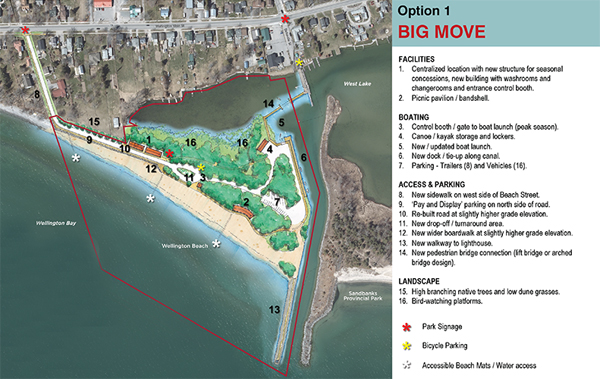 A big move concept shows how the beach could be developed over a longer period of time, with significant financial investment and major infrastructure improvements.
A big move concept shows how the beach could be developed over a longer period of time, with significant financial investment and major infrastructure improvements.
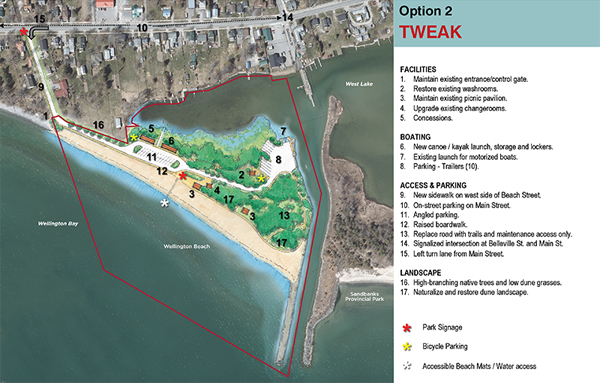 The tweak concept would entail how the beach could be improved in the immediate and interim timeframe, with modest financial investment and infrastructure improvements.
The tweak concept would entail how the beach could be improved in the immediate and interim timeframe, with modest financial investment and infrastructure improvements.
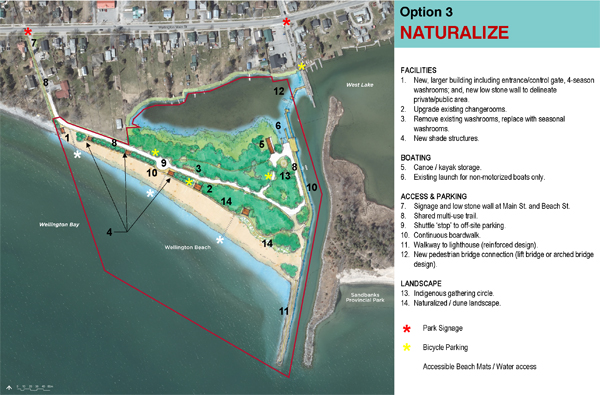 The naturalize option represents a picture of how the beach could be developed as a natural environment, where vehicle access is strictly limited to access and drop-off only.
The naturalize option represents a picture of how the beach could be developed as a natural environment, where vehicle access is strictly limited to access and drop-off only.
It was noted public input preferred the naturalize concept, followed by the tweak concept.
“The naturalize concept was preferred as it was seen to provide the least amount of noise while having the lowest environmental impact,” stated the findings. “It was also viewed as safer, with fewer vehicles and motorized boats.”
“The tweak concept was seen to balance the needs of a number of interest groups, such as boaters, bird watchers, and leisure and active beach users while flagging that improvements/upgrades to the aging amenities (roads, sidewalks, boardwalk, parking, washrooms, change huts, etc.) are required.”
From the big move concept, the findings noted interviewees liked the idea of a walking bridge to create a loop that connects the beach to Belleville Street, but felt that commercialization of the beach should be avoided.
Councillor Mike Harper noted that while the numbers haven’t been tabulated yet, there was much lower attendance this year at Wellington beach, compared to past summers, particularly during the weekdays.
He also noted the nature of the people coming to the beach was different.
“We didn’t have as many day trippers from the GTA; we had more people that were here for a holiday.”
“I think this year’s debrief on how the summer went will be really important and perhaps gives us a new way to think about what we are doing, so that’s another reason to go slow,” Harper said. “A tweak with a nod to naturalize feels like the prudent thing to do, but absolutely, it was a different kind of year.“
Results from respondents to an online survey noted visits to the beach, which are year-round, were as follows: spring (87 per cent), summer (85 per cent), fall (89 per cent) and winter (53 per cent).
Harper gave a summary of the survey results, and also highlighted brief intercept interviews conducted at a booth set up at the Wellington Canada Day street dance on the three proposed concepts.
“Of the 21 interviews, most of them liked the naturalized concept, there was some preference on the tweak concept, and we didn’t get anybody putting their hand up for the big move,” explained Harper.
“For the naturalization, what it is telling me is they like the more sedate quiet nature of it and that we are quietening it down, we are making it safe for people,” he said. “Wellington is a busy place and there is already a lot of development and they would love to keep it modest.”
He said for the tweak concept, respondents said it is pleasant right now.
“We don’t really need to deviate too far, we need to work on operations, and repair things outdated, but it was status quo for most people.”
For the online survey, Harper said 166 people responded, where he noted responses from the under 25 age group were few.
While many respondents were from Wellington, he noted that 44 per cent of survey respondents were not residents of Wellington.
“That’s an important thing to note,” Harper said.
He said some of the favourable ideas received were to improve the boardwalk, and to extend it to the lighthouse, add more landscaping, restoration of the dunes, a launch for non-motorized boats, but he also noted the interest in a pedestrian bridge given there is only one way in and one way out of the beach.
“That is actually a very important point that does limit the beach’s access and the flow of people to and from,” Harper said. “What people saw in this pedestrian bridge was a solution to that problem.”
Harper noted respondents rejected greater commercialization of the beach, but also a significant loss of parking.
“They are concerned about losing what we have, we heard there is already a lot of development and we don’t need more development.“
“We were talking about no parking, except maybe some accessible spots and trying to push everybody up to the arena or to Wellington’s Main Street, and we got a strong rejection of that.”
Adam Goheen, director of operations said the County is looking at long-term sustainability from an environmental perspective for Wellington beach.
He referenced Quinte Conservation’s new shoreline management plan, noting it recommends the County undertake a site-specific beach management plan.
“They recommend moving the parking and finding an alternative spot for the parking, dune stabilization, a sediment retention strategy for the western portion of the beach, and mitigation sediment system for the channel due to the extreme cost of dredging,” Goheen said.
“We have an opportunity here and whatever is coming out of this plan, whether it be a raised boardwalk, changing the parking implementation or whatever, we see that coming together with this beach improvement plan because if we are looking at re-naturalization, we need to look at the technical aspect of it.”
It was noted, the task team met four times during the course of the project.
Members included two CEDC representatives, two Rotary Club of Wellington members, three citizen members (one of whom is a founder of The Planning Partnership), as well as Wellington councillor, Mike Harper.
When asked how they used the beach, a broad range of uses were identified, including walking the beach on their own or with a pet, swimming, kayaking, canoeing, paddle boarding, surfing or other active watersports, launching motorized boats; birdwatching/wildlife, and sunbathing, picnicking, or other leisure uses.
The survey also asked respondents about the amenities related to each concept, such as how they felt about a rental facility for non-motorized boats, did they like the idea of a proper walkway out to the lighthouse, and how they felt about a new kayak/canoe boat launch, etc.
Some 63.9 per cent of respondents said they would like a proper walkway to the lighthouse, 63.3 per cent said they would like to see residential landscape buffers, 65.1 per cent would like an improved boardwalk, 67.9 per cent would like a new kayak/canoe launch, 67.5 per cent would like to see a naturalized and restored dune landscape, with 58.4 per cent highlighting a pedestrian bridge from the beach to Belleville Street.
Other survey responses included:
Limited paid parking and off-site parking (68.1 per cent)
Paid non-motorized boat storage (61.5 per cent)
Boat launch gate for timed entry (75.3 per cent)
Parking on Main Street (56.6 per cent)
Seasonal, fixed concessions pavilion (56.4 per cent)
Naturalization by reduced parking (60.3 per cent)
Additional picnic pavilions/band shell (51.8 per cent)
Channel retaining wall (50.6 per cent)
Centralized four-season washrooms (52.2 per cent)
Rental facility for non-motorized boats (53 per cent)
Additional shade platforms (53 per cent).
The overall findings showed more support for the naturalize and tweak concepts at 37 per cent and 36 per cent respectively, with the big move coming in at 27 per cent.
“The qualitative data showed us that multiple stakeholders have their own idea of how they would like to see the beach revitalized.”
The boat launch and parking is extremely important to some respondents, while naturalizing the beach by removing roadway access and parking is important to others.
Many who commented opposed the commercialization of the beach and preferred improvements with the least amount of environmental impact.
The task team findings identified a number of key challenges and opportunities, such high demand in the summer months, competing uses, lack of infrastructure to deal with fluctuating water levels, outdated facilities (washrooms, change huts, boardwalk), boat launch challenges, accessibility challenges, along with have only one entrance/exit to the beach.
Strengths identified by the team for the area include a natural, peaceful, gathering place, walkable and family-friendly, not overly developed, how it defines the community, as well as being municipally-owned.
It was further noted opportunity existed for environmental stewardship and improved accessibility.
“The public was clear to spend the least amount of money as possible, it boils down to who are we doing it for, and this year it was finding that balance between resident and tourist,” Harper explained. “Surveying both but recognizing that residents live here and the cost to cater to tourists also falls to the residents if we don’t charge.”
“There is a very important balance we need to strike: the right to residents to have access during the summer when right now they feel they can’t get access.“
“A tweak with some consideration for naturalization seems to be what both what people want, and what’s best for the environment,” said councillor Janice Maynard. “The other good thing is this is the least expensive option as well, and will fit well with the shoreline management plan.”
Harper also noted this study just looked at the beach, noting other issues with the channel and the marina, which is also part of the Wellington waterfront.
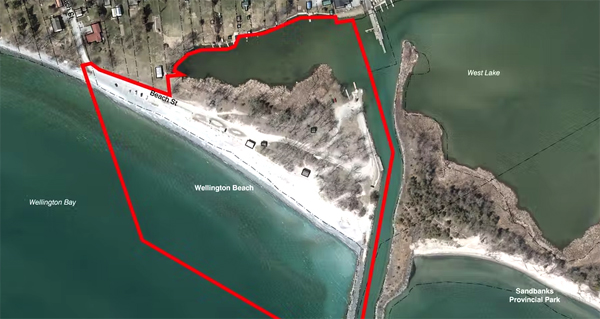 “There are these diversions beyond what the task team did and that’s why it’s a complicated project, and other considerations need to be taken into account.”
“There are these diversions beyond what the task team did and that’s why it’s a complicated project, and other considerations need to be taken into account.”
If funding is approved, next steps will see staff engage the services of a landscape architect or other qualified individuals to develop a detailed and costed plan, using the findings from the task team, as well as additional consultation with youth, the Mohawks of the Bay of Quinte, Wellington Rotary, municipal committees, Quinte Conservation and other regulatory bodies.
The Wellington Waterfront Task Team findings and survey results can be found on the County’s website Have Your Say page.
Filed Under: Featured Articles • Local News
About the Author:






























